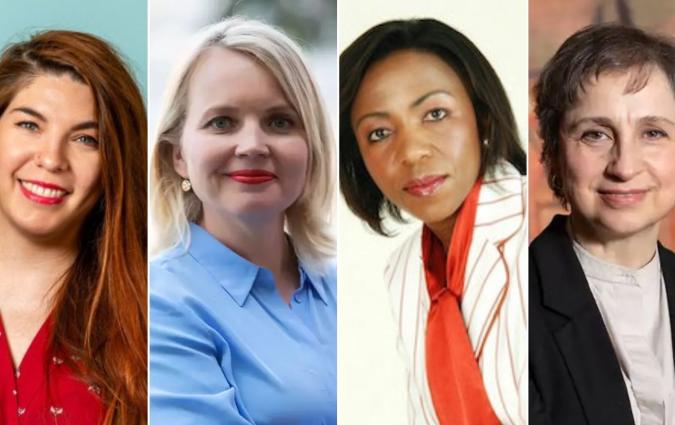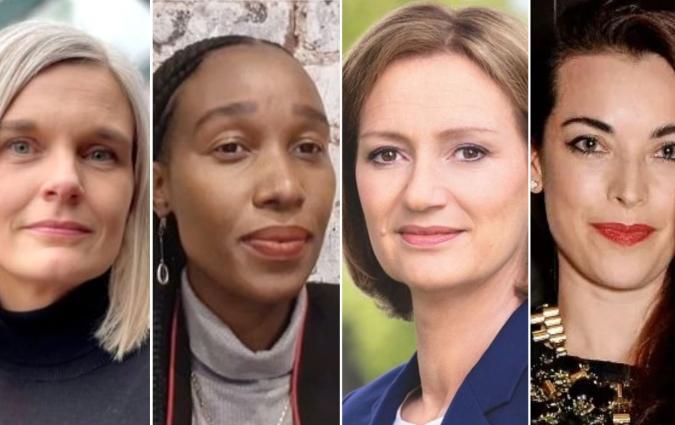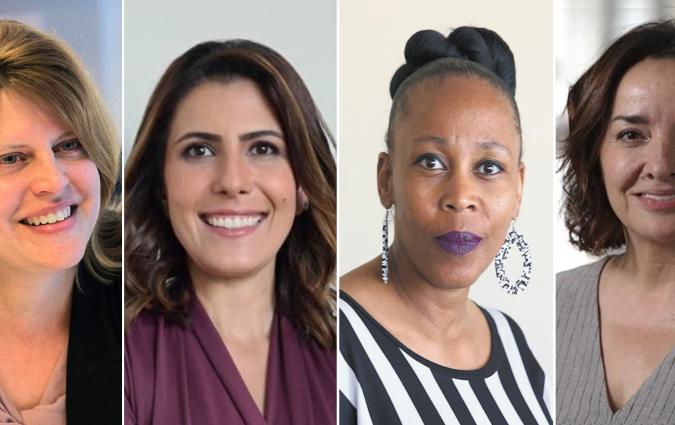In this piece
Women and leadership in the news media 2024: Evidence from 12 markets
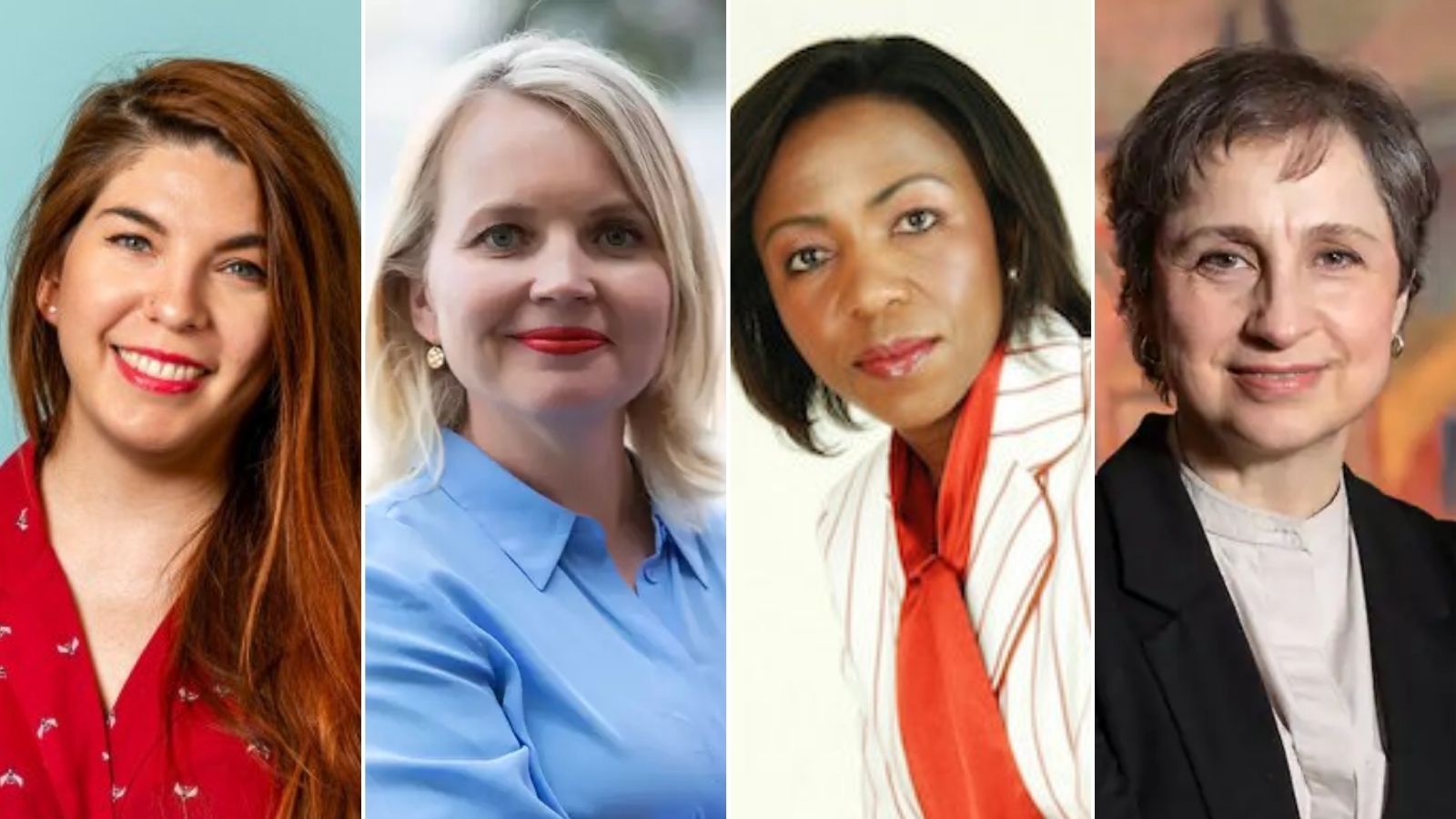
From left to right: Cate Sevilla, HuffPost UK (UK), Johanna Lahti, Ilta-Sanomat (Finland), Nada Wotshela, SABC Radio (South Africa), Carmen Aristegui, Aristegui Noticias (Mexico)
In this piece
Key findings | General overview | Methods and data | Findings | Conclusion | Footnotes | References | Acknowledgements | About the authorsKey findings
In this Reuters Institute factsheet we analyse the gender breakdown of top editors in a strategic sample of 240 major online and offline news outlets in 12 different markets across five continents.
Looking at a sample of ten top online news outlets and ten top offline news outlets in each of these 12 markets, we find:
- Only 24% of the 174 top editors across the 240 brands covered are women, despite the fact that, on average, 40% of journalists in the 12 markets are women. In 2023, this figure was 22% across the same markets.
- Among the 33 new top editors appointed across brands covered this year and last, 24% are women.
- In all 12 markets, the majority of top editors are men, including in countries where women outnumber men among working journalists.
- The percentage of women in top editorial positions varies significantly from market to market, from 0% in Japan to 43% in the US.
- When we compare the percentage of women working in journalism with the percentage of women in top editorial positions, we find a weak positive correlation. Despite this, in 11 out of 12 markets there are lower percentages of women in top editorial roles than women working as journalists.
- Looking more broadly at gender equality in society and the percentage of women in top editorial positions, this year we find no correlation. It continues to be the case that many countries that score well on the United Nations Gender Inequality Index (UN GII) have relatively few women among the top editors.
- There is notable variation in the percentage of online news users in each market who say they get news from one or more major outlets with a woman as the top editor (whether offline or online). This ranges from, at the high end, 76% in Finland to, at the low end, 17% in Mexico and, given the absence of women top editors in our sample, 0% in Japan.
- Looking across the ten markets where we have collected data for five years, the percentage of women among the top editors has changed from 23% in 2020 to 25% in 2024. A linear projection suggests that, at this pace of change, there could be gender parity in top editorial positions by the year 2074.
- But the change is not consistent across our sample – while the percentage of women in top editorial positions has increased relative to 2020 in six countries, it is the same in Mexico (6%) and Japan (0%), and it has decreased in Germany (from 27% to 25%) and South Africa (47% to 29%).
General overview
Top editorial leadership matters both in terms of how journalism is practised and how it appears in society. Therefore it is important to track who top editors are and document the extent to which they represent the wider public in all its difference and diversity.
One aspect of this issue is the gender of top editors. In this factsheet, we collect data on that across a sample of major online and offline news outlets in different markets across five continents, continuing work we have done since 2020.
We hope this will be a contribution to ongoing work done by some journalists and news media as well as some academic researchers on how, like many other forms of inequality, gender inequalities can reinforce misperceptions, imbalances, and perceived differences both within journalism and as covered by journalists.
Many recent studies have highlighted important aspects of these issues, including a lack of equal professional opportunities (for example, Alhuntushi and Lugo-Ocando 2023), underrepresentation of some voices and experiences in coverage (for example, Nwasum et al. 2023), and sexual harassment in newsrooms (for example, Blumell et al. 2023; Sbaraini Fontes et al. 2023), building on work going back years (for example, Callison and Young 2019; Carter et al. 2019; Franks 2013).
Methods and data
Building on and extending our work from past years (Andı et al. 2020; Eddy et al. 2022; Eddy et al. 2023; Robertson et al. 2021), we examine a strategic sample of 12 markets with varying levels of gender equality, as measured by the UN GII. We include the same 12 markets we covered in 2023, 2022, and 2021, ten of which we also covered in 2020. To get an overview of global differences and similarities, we include a diverse selection of markets from multiple continents. To be able to leverage available data on the journalistic profession and on news and media use, we include 12 markets from those covered in Worlds of Journalism (Hanitzsch et al. 2019) and in the Reuters Institute Digital News Report 2023 (Newman et al. 2023).1 The 12 markets included in the sample are: Kenya and South Africa in Africa; Hong Kong, Japan, and South Korea in Asia; Finland, Germany, Spain, and the UK in Europe; Mexico and the US in North America; and Brazil in South America.
In terms of data collection, our approach is identical to previous years. In each market we focused on the top ten offline (TV, print, and radio) and top ten online news brands in terms of weekly usage, as measured in the Reuters Institute Digital News Report 2023 (Newman et al. 2023). When compiling the top ten lists, we only included specific brands, leaving out catch-all categories, such as ‘local news’ or ‘regional news’. We also excluded foreign news outlets that do not have newsrooms within the country of interest. We included news aggregator brands such as Yahoo! News in the analysis if they (1) are widely used in that market, (2) have local teams based there, and (3) produce at least some original content.
Our focus on the most widely used offline and online brands means that some important outlets with more limited reach are not included in the sample (in the UK, for example, The Economist and the Financial Times, both of which have a female editor-in-chief, are not in the sample). Because of year-on-year changes in the most widely used brands and our focus on the top ten offline and online brands, there has been some turnover in the specific brands included in the analysis: 213 of the 240 brands covered in 2023 are included in the analysis again this year.
The data were collected in February 2024. We identified the top editor for each brand by checking their official webpages, press releases, and news coverage, supplemented by other public information, such as professional social media accounts (e.g. LinkedIn and X). We looked for the editor-in-chief or nearest equivalent, e.g. executive editor or head of news for TV, although the exact terminology varies from country to country and organisation to organisation. We compiled and double-checked our lists in consultation with local partners within every market, including current and former Reuters Institute Journalist Fellows and academic experts. In some cases we also contacted the brands or their press offices to confirm who is their top editor. Where organisations responded, we always deferred to their judgement.
We refer to the individuals identified collectively as the top editors. It is important to note that this, of course, does not imply that the top editor is the only person who matters, or even is always the most important person in terms of day-to-day editorial decision-making. For example, as Director General, Tim Davie is both the chief executive officer of the BBC and its editor-in-chief, both offline and online. So here he is coded as the top editor for the BBC both offline and online, even though Deborah Turness is the BBC’s CEO of news and current affairs.
In most cases, it is possible to identify a single person in the role of top editor.2 Gender is not binary, but as far as we are able to ascertain, every editor in the sample identifies as either a woman or a man. We coded observations as missing in cases where both online and offline versions of the same brand share a top editor.
In some instances, brands on our lists belong to (or have been absorbed by) larger media groups or conglomerates. In such cases, we privileged the name of the person in the top leadership role at the level of the brand listed – rather than the entire group – or in the case of some media groups in Kenya with leadership organised around medium (e.g. radio, broadcast, etc.) rather than brand, at the medium level. Likewise, when there appeared to be clear convergence between the offline and online version of a brand, with a single person in charge, we used the same top editor for both online and offline. However, when we identified a different person in charge of the online version of a brand, and especially when we understood this to be tied to distinct content and distinct editorial teams or decision-making, we used different names for the online and offline versions of the brand.
We’ve made some updates to our data set this year, where we have found new or better information about the person in the top editor role. This typically does not affect the coding, but on rare occasions it can. This year we have four such instances across the 240 observations included: one in Brazil, one in South Africa, and two in Kenya. These corrections have slightly boosted the percentage of women in both Brazil and South Africa from last year’s numbers; in these cases the increase does not reflect an actual change in staffing or brands included, but rather achange in coding. This is worth keeping in mind when interpreting the data.
In a constantly evolving media environment, where many news organisations offer little or no transparency about who is actually in charge, it sometimes requires a qualitative judgement to determine who the top editor is. Indeed, in some cases where there is no single, clearly designated editor-in-chief, or roles and responsibilities across online and offline parts of the same outlet are unclear, we have made a judgement call as to who to code as the top editor of the outlet in question. We have tried to be as clear and consistent as possible about the criteria used to code an opaque and inconsistent world. The primary point of the factsheet is to capture the overall pattern, even if in some cases individuals could have been coded differently.
In 2024, the analysis covers a total of 174 individuals across the 240 brands included. A few top editors had publicly or privately announced they were stepping down at or around the time of data collection. In these cases, where no replacement had been publicly announced by mid-February 2024, we chose to keep the outgoing top editor listed as is, and we include here the top editor as of mid-February.
Findings
Based on this dataset, we find that 24% of the 174 top editors across the 240 brands covered are women. On average, this is substantially below the 40% of journalists in the 12 markets who are women.
Compared to last year, the top line has changed in several of the countries covered, but it is important to keep in mind here that only some of this change is a result of turnover in top positions, whereas some of it has to do with changes in what brands are included in the sample (and, in the case of Brazil and South Africa, re-coding of individuals, as explained above).
Overall, the data suggest a slow pace of change and a high degree of stability in the overall pattern. 15% of the brands included in both 2023 and 2024 have changed their top editor in the past year. This is very similar to the pace of change in previous years. The percentage of women among the new top editors is 24%, the same as the percentage in the whole sample.
As is clear from Figure 1, the percentage of women in top editorial positions continues to vary significantly across the 12 markets we cover. In Japan, because of one change of top editor, and one change in which brands are included in our sample, the percentage of women among top editors has dropped to zero (the same as in 2020 and 2021). In Mexico, the figure is 6%, the same as in 2020. The highest share continues to be found in the UK (40%) and the US (45%). In all 12 markets, the majority of top editors are men.
Figure 1.
In Figure 2, we look at the relationship between the proportion of women working in journalism and the percentage of women in top editorial positions, relying on data from Worlds of Journalism (Hanitzsch et al. 2019). As in previous years, we find some evidence of a positive correlation between the percentage of women working in journalism and the percentage of women in top editorial positions, but there is a large amount of uncertainty due to the small number of data points. (And correlation does not necessarily entail causation.) Despite this pattern, there continue to be more women working as journalists than there are women among top editors in all markets covered, except the US.
Figure 2.
If we look at the percentage of women in top editorial positions in the context of data on gender inequality in society more broadly, relying on data from the UN GII (2021), shown in Figure 3, we find no correlation across 11 markets (Hong Kong is not included in the UN GII).3 This suggests that there are dynamics at play here that are specific to journalism and the news media, and which cannot be reduced to broader societal patterns of gender inequality.
Figure 3.
Finally, by combining the data collected for this Reuters Institute factsheet with data from the Reuters Institute Digital News Report 2023 (Newman et al. 2023), we can establish the proportion of people in each of the 12 markets covered who access news from at least one major news outlet with a woman as the top editor.
As Figure 4 shows, the share of online news users who say that they consume news from at least one major outlet with a woman as the top editor varies considerably across the markets covered. In Finland (76%), South Korea (73%), and South Africa (71%), a large majority does. But in many other markets, including Brazil, Germany, Kenya, Mexico, Spain, the UK, the US, and, necessarily given the absence of women among the top editors, Japan, less than half of online news users have accessed news from at least one major outlet with a woman as top editor in the past week. The average across all markets covered is 44%. This figure is slightly down from when we started this work in 2020 (when the figure was 49% across the ten markets covered).
Figure 4.
Conclusion
In this Reuters Institute factsheet, we have analysed the gender breakdown of top editors in a strategic sample of 240 major online and offline news outlets in 12 different markets across five continents. We have found that the clear majority of top editors across the sample are men. As has been the case in almost every year since we started this work in 2020, all the markets covered have a majority – often a large majority – of men in top editorial positions.
The weak positive correlation between the percentage of women working as journalists and the percentage of women among top editors, and the absence of a correlation between overall gender equality in society and the percentage of women among top editors, continues to underline that there are specific dynamics at play in journalism and the news media in terms of career progression. The issue here is not ‘only’ external and societal. It is also internal to the profession and the industry.
It is important to note here how research documents that much of the public are well aware of the lack of diversity in journalism, and that it contributes to already often low trust (Ross Arguedas et al. 2023).
Periodically, parts of the news media seem to acknowledge that the profession and the industry do not reflect the public they aim and claim to serve, and that the disparities (not only in terms of gender) are particularly pronounced in top positions.
There are, from time to time, announcements suggesting a possible intent to address these disparities and the lack of diversity, and many important entities – including the Global Alliance on Media and Gender, the International Women’s Media Foundation, and the International Center for Journalists – as well as many individuals, work hard to keep the industry’s focus on these issues.
But the current periodic interest in addressing the lack of diversity may be ebbing away. Diversity, equity, inclusion, and belonging initiatives across both the public and the private sector are reportedly in many cases fading, and in some countries face coordinated and explicit backlash from right-wing political actors (Artani 2023).
And in the news media, many are warning that the industry approach comes across as, in the words
of Shirish Kulkarni, ‘superficial and/or performative’ (Norris 2023). Looking back at recent years, Marla Jones-Newman, Vice President of People and Culture at Mother Jones says, ‘Much has changed. Much has not.’ (Jones-Newman 2023).
Our five years of data certainly supports the latter. Looking across the ten markets where we have collected data for five years, the percentage of women among the top editors has changed from 23% in 2020 to 25% in 2024. Although covering a limited number of years and a limited number of brands, our coding of 871 data points can provide a basis for assessing the pace of change in the industry and offer some cautious projections. A simple linear projection of the two-percentage-point change over these four years suggests that there could be gender parity in top editorial positions by 2074. A more cautious projection, looking at the average percentage of women in our sample across the five years in ten markets, suggests that, at the current pace of change, there will never be gender parity among top editors in the news media.
What does the future hold? We will know more when we repeat this analysis and publish new data in 2025 to track developments in gender equality among top editors across the world.
Footnotes
1 The Worlds of Journalism data is not collected as frequently as the Digital News Report data or the UN GII data, but we use it here as the best available cross-country comparative data on the gender breakdown of the journalistic workforce. The data from Hanitzsch et al. (2019) used in this analysis were collected between 2012 and 2016.
2 The main exception to this is in Germany, where organisations sometimes have shared top leadership. Three such cases with joint man-woman top editors were present in this year’s data. Two of these instances corresponded to the online and offline version of a single brand, which has the same leadership for both, so we coded one each (i.e. the offline as led by a woman and online as led by a man). For the third brand, since there was only one data point, we simply coded the top editor as a woman.
3 UN GII rankings were re-coded for interpretability, with the highest-ranked (worst GII score) country coded here as 1 and the lowest-ranked (best GII score) country coded here as 11.

References
- Alhuntushi, A., Lugo-Ocando, J. 2023. Science Journalism in the Arab World: The Quest for ‘Ilm’ and Truth. Cham, Switzerland: Springer.
- Andı, S., Selva, M., Nielsen, R. K. 2020. Women and Leadership in the News Media 2020: Evidence from Ten Markets. Oxford: Reuters Institute for the Study of Journalism.
- Aratani, L. 2023. ‘Diversity policies face “full-out attack” in 2024, leading HR boss warns’, Guardian, 16 December. (Accessed Feb. 2024).
- Blumell, L. E., Mulupi, D., Arafat, R. 2023. ‘The Impact of Sexual Harassment on Job Satisfaction in Newsrooms’, Journalism Practice, 1–20.
- Callison, C., Young, M. L. 2019. Reckoning: Journalism’s Limits and Possibilities. Oxford: Oxford University Press.
- Carter, C., Steiner, L., Allan, S. 2019. Journalism, Gender and Power. Abingdon: Routledge.
- Eddy, K., Ross Arguedas, A., Mukherjee, M., Nielsen, R. K. 2023. Women and Leadership in the News Media 2023: Evidence from 12 Markets. Oxford: Reuters Institute for the Study of Journalism.
- Eddy, K., Selva, M., Nielsen, R. K. 2022. Women and Leadership in the News Media 2022: Evidence from 12 Markets. Oxford: Reuters Institute for the Study of Journalism.
- Franks, S. 2013. Women and Journalism. Oxford: Reuters Institute for the Study of Journalism.
- Hanitzsch, T., Hanusch, F., Ramaprasad, J., De Beer, A. 2019. Worlds of Journalism: Journalistic Cultures Around the Globe. New York: Columbia University Press.
- Jones-Newman, M. 2023. ‘Three Years After George Floyd, Newsroom Diversity Initiatives Are Dying Back’, Mother Jones, 25 May. (Accessed Feb. 2024).
- Newman, N., Fletcher, R., Eddy, K., Robertson, C. T., Nielsen, R. K. 2023. Reuters Institute Digital News Report 2023. Oxford: Reuters Institute for the Study of Journalism.
- Norris, A. 2023. ‘Shirish Kulkarni: “What Media Companies Get Wrong About Diversity, Equity & Inclusion”’. Media Makers Meet, 18 September. (Accessed Feb. 2024).
- Nwasum, C. J., Ogbodo, J., Chukwu, J. N., Nwakpu, E. S. 2023. ‘One Human, Unequal Gender: A Critical Appraisal of Women and News Creation in Nigeria’, in M. Topić (ed.) Women and the Media in Capitalism and Socialism. Bristol: Intellect.
- Robertson, C. T., Selva, M., Nielsen, R. K. 2021. Women and Leadership in the News Media 2021: Evidence from 12 Markets. Oxford: Reuters Institute for the Study of Journalism.
- Ross Arguedas, A., Banerjee, S., Mont’Alverne, C., Toff, B., Fletcher, R., Nielsen, R. K. 2023. News for the Powerful and Privileged: How Misrepresentation and Underrepresentation of Disadvantaged Communities Undermines Their Trust in News. Oxford: Reuters Institute for the Study of Journalism.
- Sbaraini Fontes, G., Barão da Silva, G., Marques, F. P. J. 2023. ‘“It Was All About Being ‘Young’, ‘Cute’, and ‘Funny’”: How Women Journalists Assess Harassment and Gender Inequalities in Brazilian Newsrooms’, Feminist Media Studies, 1–17.
 Acknowledgements
Acknowledgements
The authors would like to thank Luiz Fernando Boaventura Teixeira, Emily Chan Miu Ling, Kirsten Eddy, Daisuke Furuta, Sonho Kim, Jussi Latvala, Cheris Leung, Camila Mont’Alverne, Tania Montalvo, Nic Newman, Maurice Oniang’o, Mpho Raborife, Anne Schulz, Felix Simon, and Eduardo Suárez for their valuable time, input, and feedback.
About the authors
Amy Ross Arguedas is a Research Fellow at the Reuters Institute for the Study of Journalism.
Mitali Mukherjee is the Director of the Journalist Programmes at the Reuters Institute for the Study of Journalism.
Rasmus Kleis Nielsen is the Director of the Reuters Institute for the Study of Journalism and Professor of Political Communication at the University of Oxford.
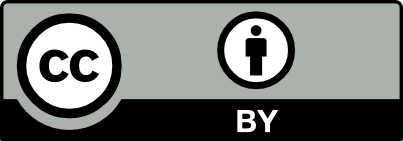
This report can be reproduced under the Creative Commons licence CC BY.
In every email we send you'll find original reporting, evidence-based insights, online seminars and readings curated from 100s of sources - all in 5 minutes.
- Twice a week
- More than 20,000 people receive it
- Unsubscribe any time


